In Silico Screening of Semi-Synthesized Compounds as Potential Inhibitors for SARS-CoV-2 Papain-like Protease: Pharmacophoric Features, Molecular Docking, ADMET, Toxicity and DFT Studies
- PMID: 34771004
- PMCID: PMC8588135
- DOI: 10.3390/molecules26216593
In Silico Screening of Semi-Synthesized Compounds as Potential Inhibitors for SARS-CoV-2 Papain-like Protease: Pharmacophoric Features, Molecular Docking, ADMET, Toxicity and DFT Studies
Abstract
Papain-like protease is an essential enzyme in the proteolytic processing required for the replication of SARS-CoV-2. Accordingly, such an enzyme is an important target for the development of anti-SARS-CoV-2 agents which may reduce the mortality associated with outbreaks of SARS-CoV-2. A set of 69 semi-synthesized molecules that exhibited the structural features of SARS-CoV-2 papain-like protease inhibitors (PLPI) were docked against the coronavirus papain-like protease (PLpro) enzyme (PDB ID: (4OW0). Docking studies showed that derivatives 34 and 58 were better than the co-crystallized ligand while derivatives 17, 28, 31, 40, 41, 43, 47, 54, and 65 exhibited good binding modes and binding free energies. The pharmacokinetic profiling study was conducted according to the four principles of the Lipinski rules and excluded derivative 31. Furthermore, ADMET and toxicity studies showed that derivatives 28, 34, and 47 have the potential to be drugs and have been demonstrated as safe when assessed via seven toxicity models. Finally, comparing the molecular orbital energies and the molecular electrostatic potential maps of 28, 34, and 47 against the co-crystallized ligand in a DFT study indicated that 28 is the most promising candidate to interact with the target receptor (PLpro).
Keywords: ADMET; COVID-19; DFT; molecular docking; papain-like protease; pharmacophore; semi-synthesized; toxicity.
Conflict of interest statement
The authors declare no conflict of interest.
Figures
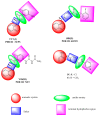
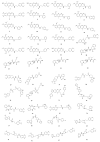



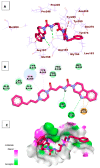
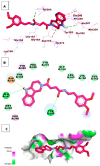
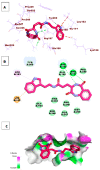
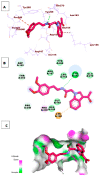
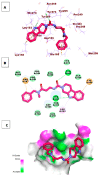
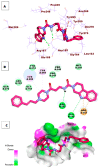

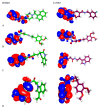


Similar articles
-
In silico screening of phytopolyphenolics for the identification of bioactive compounds as novel protease inhibitors effective against SARS-CoV-2.J Biomol Struct Dyn. 2022;40(20):10437-10453. doi: 10.1080/07391102.2021.1944909. Epub 2021 Jun 28. J Biomol Struct Dyn. 2022. PMID: 34182889
-
Microbial based natural compounds as potential inhibitors for SARS-CoV-2 Papain-like protease (PLpro): a molecular docking and dynamic simulation study.J Biomol Struct Dyn. 2022;40(24):13848-13858. doi: 10.1080/07391102.2021.1997815. Epub 2021 Nov 3. J Biomol Struct Dyn. 2022. PMID: 34730069
-
Exploring Cannabinoids as Potential Inhibitors of SARS-CoV-2 Papain-like Protease: Insights from Computational Analysis and Molecular Dynamics Simulations.Viruses. 2024 May 30;16(6):878. doi: 10.3390/v16060878. Viruses. 2024. PMID: 38932170 Free PMC article.
-
Analysis of Structures of SARS-CoV-2 Papain-like Protease Bound with Ligands Unveils Structural Features for Inhibiting the Enzyme.Molecules. 2025 Jan 23;30(3):491. doi: 10.3390/molecules30030491. Molecules. 2025. PMID: 39942596 Free PMC article. Review.
-
Chalcone-amide, a privileged backbone for the design and development of selective SARS-CoV/SARS-CoV-2 papain-like protease inhibitors.Eur J Med Chem. 2022 Oct 5;240:114572. doi: 10.1016/j.ejmech.2022.114572. Epub 2022 Jul 3. Eur J Med Chem. 2022. PMID: 35797899 Free PMC article. Review.
Cited by
-
Design, synthesis, anti-proliferative evaluation, docking, and MD simulations studies of new thiazolidine-2,4-diones targeting VEGFR-2 and apoptosis pathway.PLoS One. 2022 Sep 23;17(9):e0272362. doi: 10.1371/journal.pone.0272362. eCollection 2022. PLoS One. 2022. PMID: 36149902 Free PMC article.
-
Multi-Step In Silico Discovery of Natural Drugs against COVID-19 Targeting Main Protease.Int J Mol Sci. 2022 Jun 21;23(13):6912. doi: 10.3390/ijms23136912. Int J Mol Sci. 2022. PMID: 35805916 Free PMC article.
-
Novel Insights in the Hypertension Treatment & Type 2 Diabetics Induced by Angiotensin Receptor Blockers: MD Simulation Studies & Molecular Docking of Some Promising Natural Therapies.ACS Omega. 2024 May 2;9(19):21234-21244. doi: 10.1021/acsomega.4c01319. eCollection 2024 May 14. ACS Omega. 2024. PMID: 38764667 Free PMC article.
-
Investigation of substituent effects on the electronic structure and antiviral activity of favipiravir derivatives for Covid-19 treatment using DFT and molecular docking.Sci Rep. 2024 Jul 31;14(1):17697. doi: 10.1038/s41598-024-68712-0. Sci Rep. 2024. PMID: 39085399 Free PMC article.
-
A Multistage In Silico Study of Natural Potential Inhibitors Targeting SARS-CoV-2 Main Protease.Int J Mol Sci. 2022 Jul 29;23(15):8407. doi: 10.3390/ijms23158407. Int J Mol Sci. 2022. PMID: 35955547 Free PMC article.
References
-
- WHO WHO Coronavirus (COVID-19) Dashboard. [(accessed on 10 September 2021)]. Available online: https://covid19.who.int/
-
- Li N., Wang Y., Li W., Li H., Yang L., Wang J., Mahdy H.A., Mehany A., Jaiash D.A., Santali E.Y. Screening of Some Sulfonamide and Sulfonylurea Derivatives as Anti-Alzheimer’s Agents Targeting BACE1 and PPARγ. J. Chem. 2020;2020:1631243. doi: 10.1155/2020/1631243. - DOI
-
- Abdel-Aziz H.A., Eldehna W.M., Fares M., Al-Rashood S.T., Al-Rashood K.A., Abdel-Aziz M.M., Soliman D.H. Synthesis, biological evaluation and 2D-QSAR study of halophenyl bis-hydrazones as antimicrobial and antitubercular agents. Int. J. Mol. Sci. 2015;16:8719–8743. doi: 10.3390/ijms16048719. - DOI - PMC - PubMed
MeSH terms
Substances
Grants and funding
LinkOut - more resources
Full Text Sources
Miscellaneous

